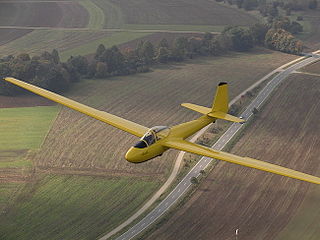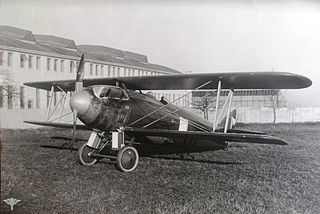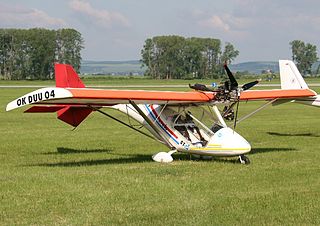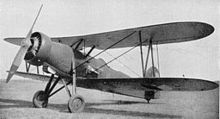Construcciones Aeronáuticas SA (CASA) was a Spanish aircraft manufacturer that was founded in 1923 and began manufacturing aircraft the following year. In 1999 it became a subsidiary of the EADS under the name EADS CASA and in 2009 was absorbed into Airbus Military. CASA is noted for designing and producing military transport aircraft such as the CASA C-212 Aviocar, the CASA CN-235, the CASA C-295 and the CASA C-101 trainer/ground attack aircraft.

PZL was the largest Polish aerospace manufacturer of the interwar period, and a brand of their aircraft. Based in Warsaw between 1928 and 1939, PZL introduced a variety of well-regarded aircraft, most notably the PZL P.11 fighter, the PZL.23 Karaś light bomber, and the PZL.37 Łoś medium bomber.

Hindustan Aeronautics Limited (HAL) is an Indian public sector aerospace and defence company, headquartered in Bangalore. Established on 23 December 1940, HAL is one of the oldest and largest aerospace and defence manufacturers in the world. HAL began aircraft manufacturing as early as 1942 with licensed production of Harlow PC-5, Curtiss P-36 Hawk and Vultee A-31 Vengeance for the Indian Air Force. HAL currently has 11 dedicated Research and development (R&D) centres and 21 manufacturing divisions under 4 production units spread across India. HAL is managed by a board of directors appointed by the President of India through the Ministry of Defence, Government of India. HAL is currently involved in designing and manufacturing of fighter jets, helicopters, jet engine and marine gas turbine engine, avionics, software development, spares supply, overhauling and upgrading of Indian military aircraft.

Junkers Flugzeug- und Motorenwerke AG more commonly Junkers, was a major German aircraft and aircraft engine manufacturer. It was founded in Dessau, Germany, in 1895 by Hugo Junkers, initially manufacturing boilers and radiators. During World War I and following the war, the company became famous for its pioneering all-metal aircraft. During World War II the company produced the German air force's planes, as well as piston and jet aircraft engines, albeit in the absence of its founder who had been removed by the Nazis in 1934.

The Junkers Ju 287 was a multi-engine tactical jet bomber built in Nazi Germany in 1944. It featured a novel forward-swept wing, and the first two prototypes were among the very few jet propelled aircraft ever built with fixed landing gear.
Aero Vodochody is a Czech aircraft company. Its main production facilities are located at Vodochody Airport in the Prague-East District, on the municipal territories of Vodochody and Odolena Voda.

The Junkers Ju 290 was a large German, four-engine long-range transport, heavy bomber and maritime patrol aircraft used by the Luftwaffe late in World War II. It was developed from an airliner.

PZL Mielec, formerly WSK-Mielec and WSK "PZL-Mielec" is a Polish aerospace manufacturer based in Mielec. It is the largest aerospace manufacturer in postwar Poland. In 2007, it was acquired by Sikorsky Aircraft Corporation, which retained the brand name. Between 1948 and 2014, the company manufactured approximately 15,600 aircraft.

The Aero A.14 was a Czechoslovakian biplane military reconnaissance aircraft built in the 1920s. It was essentially a slightly modified version of the Hansa-Brandenburg C.I aircraft that Aero had built during World War I as the Ae.10, and for this reason, the aircraft is sometimes referred to as the A.14 Brandenburg. When equipped with a slightly different engine, the aircraft was designated A.15 instead. The two versions were otherwise almost identical.

The Aero A.304 was a Czechoslovakian bomber aircraft that first flew in 1937. It had originally been developed as an airliner, the A.204, but when Aero could not find buyers for the design, it was militarised and successfully marketed to the Czechoslovak Air Force.

Avia Motors s.r.o. is a Czech automotive manufacturer. Founded in 1919 as an aircraft maker, it diversified into trucks after 1945. As an aircraft maker it was notable for producing biplane fighter aircraft, especially the B-534. Avia ceased aircraft production in 1963.

Aircraft Industries, a.s., operating as Let, is a Czech civil aircraft manufacturer. Its most successful design has been the L-410 Turbolet, of which more than 1300 units have been built. Its head office is in Kunovice, Zlín Region. Let was owned by the Russian company UGMK from 2008 to 2022, when it was acquired by Czech-based Omnipol Group.

Zlin Aircraft a.s. is a Czech light aircraft company. It is located at the Zlín Airfield on the outskirts of Otrokovice. It is known for the line of Z-26 Trener and other small aircraft like crop-dusting Z-37 and aerobatics special Z-50.

The LF-107 Luňák is a Czech aerobatic glider designed by Prague-based company Rudý Letov in the late 1940s. The design was developed within a prolific group of aeronautical engineers and sailplane pilots, including K. Dlouhý, J. Matejček, and B. Boček, led by chief designer Vladimír Štros.

Tbilisi Aircraft Manufacturing (TAM), also known as JSC Tbilaviamsheni, is a Georgian aerospace development and manufacturing company, which also partially manufactures APCs and IFVs.

The Slovak Air Force, between 1939 and 1945, was the air force of the short-lived World War II Slovak Republic. Its mission was to provide air support at fronts, and to protect Bratislava and metropolitan areas against enemy air attack.

The Czechoslovak Air Force or the Czechoslovak Army Air Force was the air force branch of the Czechoslovak Army formed in October 1918. The armed forces of Czechoslovakia ceased to exist on 31 December 1992. By the end of the year, all aircraft of the Czechoslovak Air Force were divided between the Czech Air Force and the Slovak Air Force.

The Letov Š-20 was a fighter aircraft produced in Czechoslovakia during the 1920s.

The Letov ST-4 Aztek is a Czech microlight aircraft that was designed and produced by Letov Kbely of Prague - Letňany, in the 1990s. When it was available, the aircraft was supplied as a complete ready-to-fly aircraft, or as a kit for amateur construction.

Kingdom of Serbia became part of the new state, Kingdom of the Serbs, Croats and Slovenes. which was formed on 1 December 1918. Even though the industry was on a very low level of development, the state was among the first 10 countries in the world which developed their own aircraft production. Originally, only the parts produced in foreign factories were assembled, but very soon the production of domestic components began, so as the engineering. The forerunner of the domestic aircraft industry was the Airplane workshop, which was established in 1920, at the airfield in Novi Sad. The assembling of the trial series of Hansa-Brandenburg C.I. The series was named SBr, as this type of plane was known in Serbia as srednji Brandenburg.
























